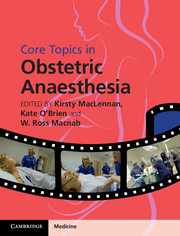Book contents
- Frontmatter
- Contents
- List of contributors
- Preface
- Section 1 Basic science, epidemiology and service organization
- Section 2 Obstetric aspects
- Section 3 Provision of anaesthesia
- Section 4 Medical conditions in pregnancy
- 14 Hypertension in pregnancy, pre-eclampsia and eclampsia
- 15 Sepsis and influenza in pregnancy
- 16 Cardiac disease in pregnancy
- 17 Respiratory disease in pregnancy
- 18 Obesity and ultrasonography for central neuraxial blocks
- 19 Endocrine disease in pregnancy including diabetes mellitus, thyroid and adrenal disease
- 20 Renal disease
- 21 Haematologic disease in pregnancy
- 22 Neurosurgical and neurological disease in pregnancy
- 23 Immunology, including testing and management of allergy during pregnancy
- 24 HIV and infectious disease in pregnancy, including herpes, syphilis and hepatitis
- Section 5 Postpartum complications and obstetric emergencies
- Section 6 Service organization
- Index
- Plate section
- References
24 - HIV and infectious disease in pregnancy, including herpes, syphilis and hepatitis
from Section 4 - Medical conditions in pregnancy
Published online by Cambridge University Press: 05 December 2015
- Frontmatter
- Contents
- List of contributors
- Preface
- Section 1 Basic science, epidemiology and service organization
- Section 2 Obstetric aspects
- Section 3 Provision of anaesthesia
- Section 4 Medical conditions in pregnancy
- 14 Hypertension in pregnancy, pre-eclampsia and eclampsia
- 15 Sepsis and influenza in pregnancy
- 16 Cardiac disease in pregnancy
- 17 Respiratory disease in pregnancy
- 18 Obesity and ultrasonography for central neuraxial blocks
- 19 Endocrine disease in pregnancy including diabetes mellitus, thyroid and adrenal disease
- 20 Renal disease
- 21 Haematologic disease in pregnancy
- 22 Neurosurgical and neurological disease in pregnancy
- 23 Immunology, including testing and management of allergy during pregnancy
- 24 HIV and infectious disease in pregnancy, including herpes, syphilis and hepatitis
- Section 5 Postpartum complications and obstetric emergencies
- Section 6 Service organization
- Index
- Plate section
- References
Summary
HIV
Introduction
Human immunodeficiency virus (HIV) is a retrovirus acquired by direct inoculation of infected bodily fluids. This is most often during sexual intimacy, but may also result from contaminated needles or iatrogenic interventions, such as blood transfusion or surgical procedures with contaminated products. The infection is lifelong and if untreated significant morbidity and mortality arise from HIV-associated infections and malignancies; this is termed the acquired immune deficiency syndrome (AIDS). During infection, HIV enters cells presenting CD4 receptors, the most common being the CD4+ T lymphocyte. Within the hosting cell, HIV replication, virion release and eventual cell death occur. The main measurable and prognostic parameters widely used are quantification of peripheral CD4 cells (the CD4 count), and the level of viraemia (HIV viral load). The likelihood of AIDS-defining illness developing increases with progressive CD4+ cell depletion, which occurs steadily over time from infection and more rapidly in individuals with a higher HIV viral load.
The advent of highly active antiretroviral therapy (HAART) in the late 1990s transformed the management of HIV-positive patients, and the infection is now generally treatable with a good prognosis, particularly when detected early. In addition to this, effective HAART together with appropriate obstetric management, infant antiretroviral prophylaxis and avoidance of breastfeeding has reduced rates of mother-to-child transmission (MTCT) of HIV significantly. Universal screening for HIV in UK antenatal clinics from 1999 onwards, followed by appropriate management of mothers and their babies, has resulted in MTCT rates falling from between 20–30%, depending on maternal viral load in the mid-1990s to less than 1% in 2010. Worldwide, of the 34 million people living with HIV, 69% reside in sub-Saharan Africa, with other high-prevalence areas including Asia, the Caribbean and Eastern Europe. Many HIV-positive parturients receiving their antenatal care in the UK have acquired HIV whilst residing in one of the pandemic areas. The estimated UK prevalence in 2009 was 2.2 per 1000 women giving birth; most of these live in urban areas, with London having the highest rates.
Effect of HIV on pregnancy
HIV infection itself does not cause sub-fertility, although HIV-positive women may have decreased fertility due to associated conditions such as concurrent infections or illnesses, opiate use and low weight. HAART itself, particularly protease inhibitors, has been associated with preterm delivery in some studies, but not in others.
- Type
- Chapter
- Information
- Core Topics in Obstetric Anaesthesia , pp. 185 - 190Publisher: Cambridge University PressPrint publication year: 2015



